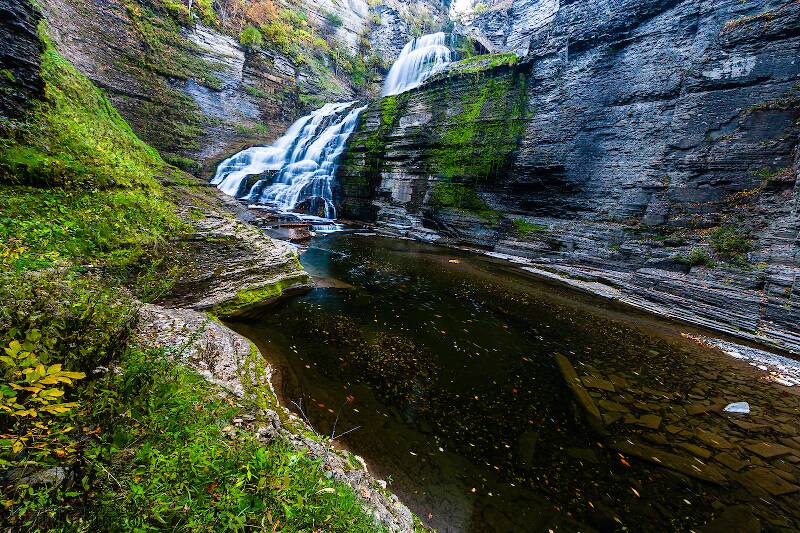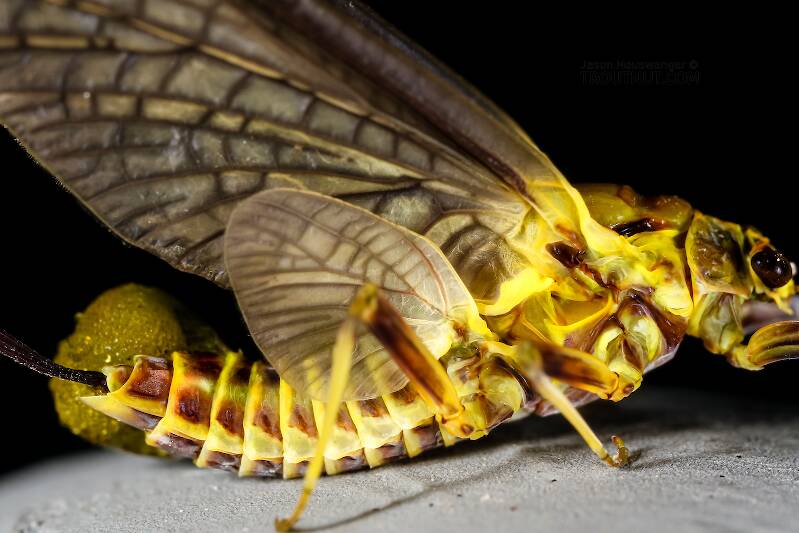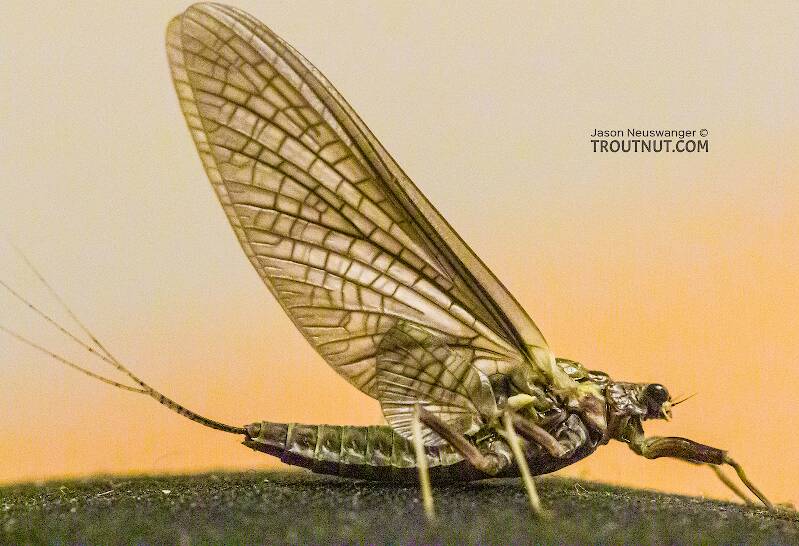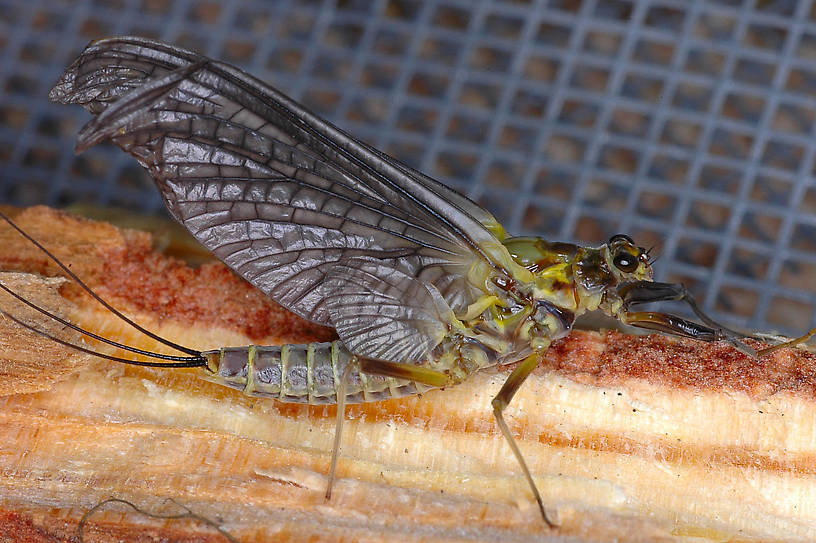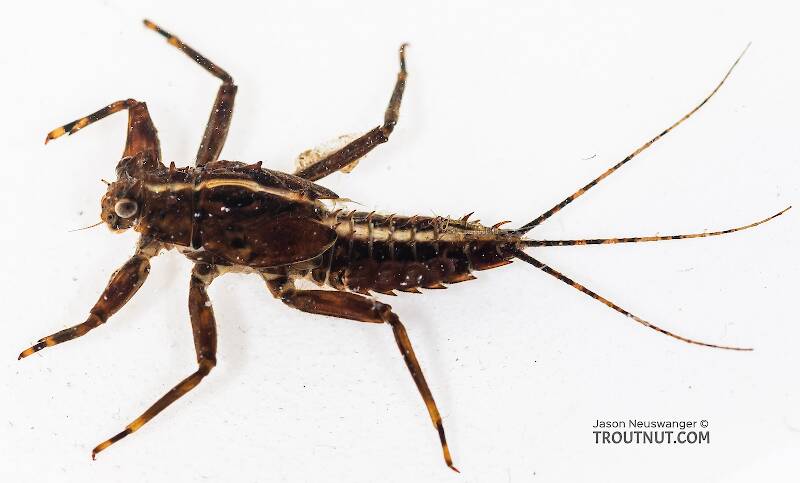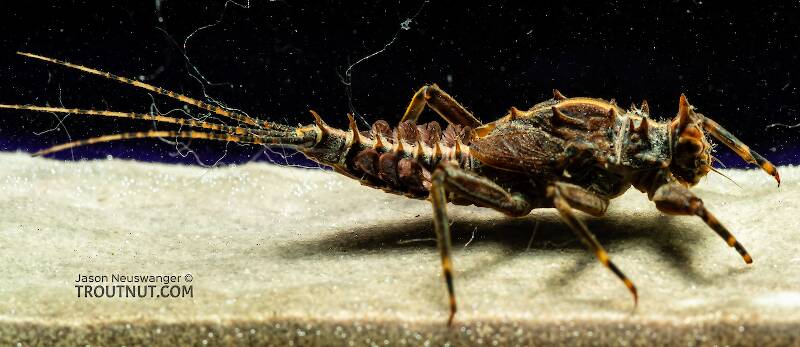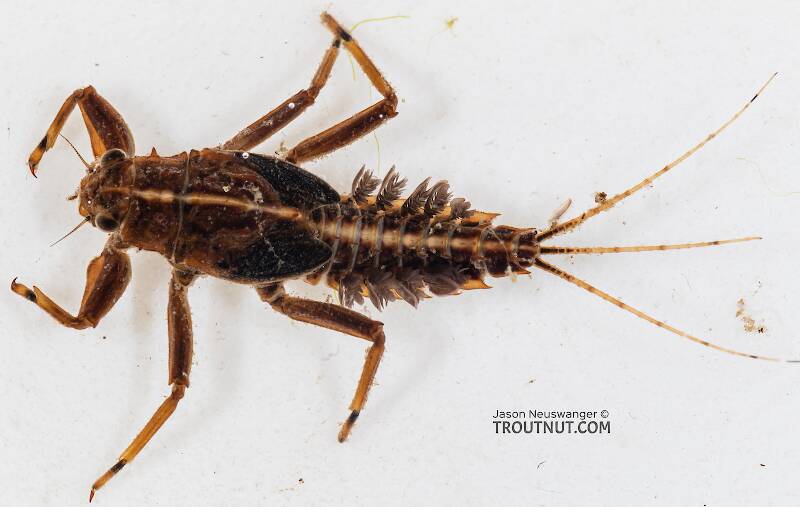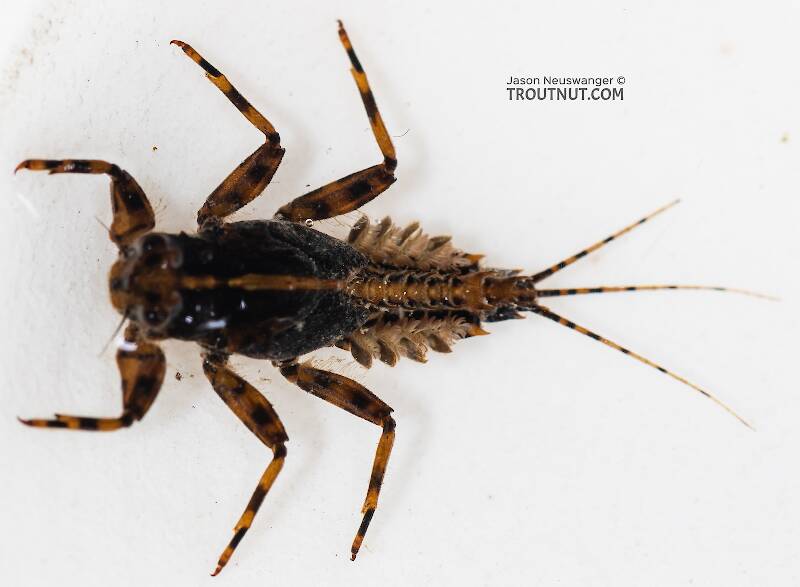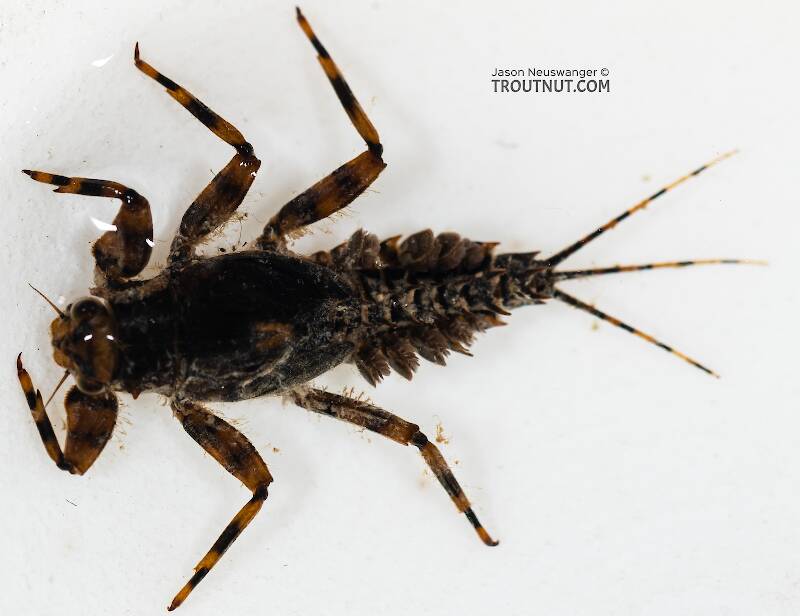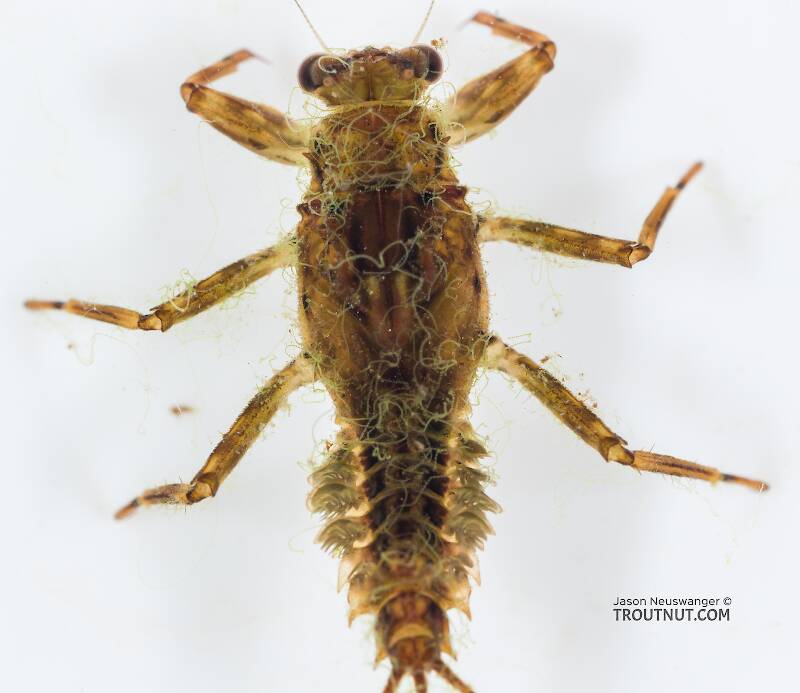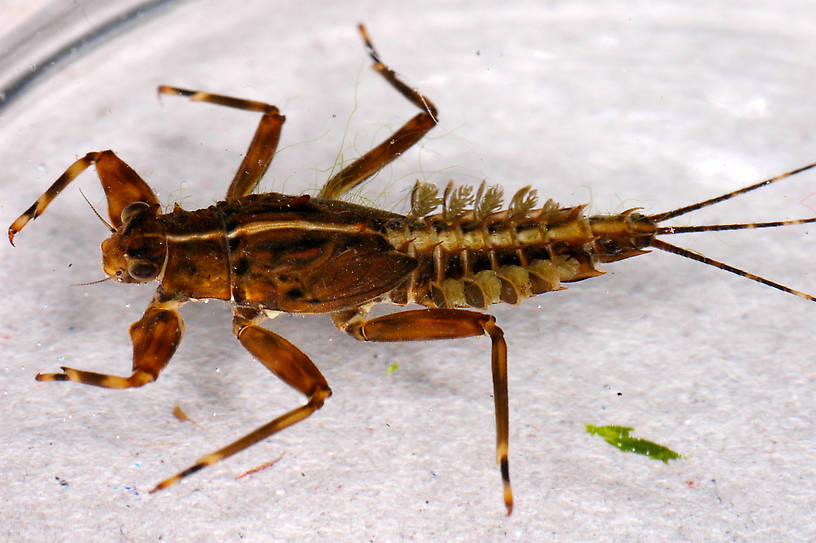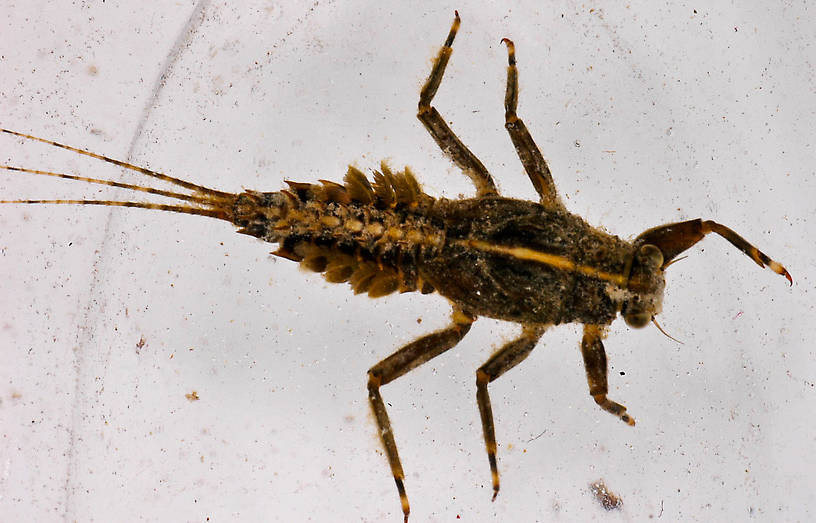
Blue-winged Olives
Baetis
Tiny Baetis mayflies are perhaps the most commonly encountered and imitated by anglers on all American trout streams due to their great abundance, widespread distribution, and trout-friendly emergence habits.


Mayfly Species Drunella grandis (Western Green Drakes)
It hasn't been all that many years since Western traditions and entomological "facts on the ground" began to influence the angler's lexicon heavily dominated by Eastern writers. Their initial reporting after visiting the region first popularized the phrase "Rocky Mountains answer to the popular Green Drakes of the East". This led to a false impression that lingers to this day. The reality is these giants of their family have abundant populations all over the West with no counterpart in the East, and the West does have abundant hatches of comparable Ephemeridae. The Western tradition of naming outsized Mayflies "Drakes" is the reason for what many consider a misnomer by giving it the same common name as the legendary Ephemerid of the East and surely contributed to confusion for anglers unconcerned with such subtleties.
Where & when
The Western Green Drakes are very widespread and important, causing some of the best fishing of the season throughout their range, from Yellowstone to California to Alaska.Caucci and Nastasi report that this hatch begins and ends a few weeks earlier on spring creeks, where they are especially prolific, than on freestone rivers.
In 11 records from GBIF, adults of this species have been collected during June (36%), July (18%), April (18%), May (9%), February (9%), and November (9%).
In 40 records from GBIF, this species has been collected at elevations ranging from 259 to 10007 ft, with an average (median) of 6565 ft.
Species Range
Hatching behavior
Emergence may occur late in the morning early in the year or at high altitudes, but it progresses through the afternoon and into the evening as the season heats up. Most authors suggest that the best fishing at the peak of the hatch is in the evening, but others say the best hatching is in the early to mid-afternoon. All agree that it can last for several hours on a good day.
Like all common Drunella species, these duns quickly change color once they're exposed to the air. Anglers should imitate the bright green of the freshly emergent duns rather than the dark ruddy brown color they display later.
Spinner behavior
According to Hatches II, spinner flights are most common during the day:The initial spinner flights of these species may occur at midday. As the weather climbs into the 80's and 90's, they will progressively fall later until they occur at dusk. In August, the spinner flight may take place during mid-morning...
However, according to Mayflies: An Angler's Study of Trout Water Ephemeroptera and Mayflies, the Angler, and the Trout, the spinners are active in the middle of the night. Arbona writes:
Daytime spinner flights are very sparse for such a common species because the large spinners do not become active until well after nightfall, and ovipositing is accomplished at 4am.
Most angler reporting concurs with the latter.
Nymph biology
Current speed: Medium to fast
Like others in the Ephemerellidae, these nymphs often swim to and from the surface several times prior to emerging, and imitating this behavior is effective in the hours before the hatch. There is also evidence that the duns often emerge subsurface as well. This is given testimony by the frequent success of emerging dun wet flies.
Identification
To determine whether a specimen of Drunella belongs to Drunella grandis, use the Key to Species of Drunella Nymphs.
Drunella grandis Fly Fishing Tips
As with the Eastern hatches of Isonychia bicolor, trout become strongly conditioned to watch for these meaty duns on the surface. Their imitations make excellent attractor flies on days when their hatch is off or even after it has ended.Physical description
Most physical descriptions on Troutnut are direct or slightly edited quotes from the original scientific sources describing or updating the species, although there may be errors in copying them to this website. Such descriptions aren't always definitive, because species often turn out to be more variable than the original describers observed. In some cases, only a single specimen was described! However, they are useful starting points.
Male Spinner
Wing length: 15-18 mm
A species of the fuscata group (now a synonym of Drunella walkeri). Male imago very similar to that of E. doddsi (now a synonym of Drunella doddsii), but distinguished by the greater amount of dark coloring on the femora and the abdominal tergites, the pale middle and hind tarsi, and the structure of the forceps.
Head and thorax dark reddish brown. Pleural sutures and an area anterior to the wing roots pale. Scutellum bordered with blackish brown; its spine quite slender and long. Fore legs brownish, tarsi somewhat paler. Middle and hind legs pale yellowish white. All femora washed with purplish brown, and with wide dark brown subapical bands. Wings hyaline; longitudinal veins dark purplish brown. Abdominal segments dark purplish brown with wide pale margins, so as to appear conspicuously ringed. Pleural fold whitish. Segments 8-10 largely dark; 8 and 10 with pale posterior margins. Tails deep purplish brown at base, becoming paler towards the tips. Second joint of the forceps relatively straight, not much swollen; third joint rather short (see fig. 153).
Described as E. flavitincta
Body length 15 mm, wing length 18 mm
A species of the fuscata group (now a synonym of Drunella walkeri), allied to E. glacialis (now a synonym of Drunella grandis); wings are tinged with light amber. Head black; pits at bases of antennae yellowish. Thorax shiny black. Intersegmental areas of pleura dull yellow-brown; brighter yellow around bases of legs. Fore legs deep black, tarsi slightly paler. Coxae and trochanters of middle and hind legs blackish, ring of membrane between them yellowish. Femora largely black, yellowish on basal margin. Tibiae and tarsi rather bright yellow; distal tarsal joint tinged with smoky. Wings hyaline, “tinted with light amber, the color paling apically; veins and cross veins strong, blackish,” (McD.), stigmatic cross veins rather faint. No fusion between posterior branch of median and Cu1.
Abdominal tergites black; posterior margins narrowly pale yellowish, “most noticeably in lateral angles and on segments 8 and 9, the other portions being somewhat dulled (at least in specimen examined) with smoky brown.” (McD.). Sternites black; posterior margins of sternites 1-7 rather bright yellow; sternites 8 and 9 wholly black. Forceps entirely black. Tails black, becoming pale smoky apically.
The large size and the amber-tinged wings of the imago should distinguish this species from all others in the genus.
Described as E. ingens
Body length 13-15 mm, wing length 16-18 mm
Eyes deep blackish brown. Head black. Pits of antennae and a small area posterior to the middle ocellus pale yellowish. Pronotum black. Mesonotum black, lateral posterior margins shaded slightly with brown. “Membranous area between base of wing and fore coxa pale yellowish, shaded with light brown, and containing a blackish streak” (McD.). Metathorax black; slight yellow shading on median area of notum, and on pleura between sclerites and around leg bases. Fore legs blackish; edges of femur near base with pale smoky yellow tinge. Coxae and femora of middle and hind legs blackish; femora and trochanters tinged with dull yellowish at base and on edges. Tibia as long as femur and trochanter together, dull yellowish. Tarsus smoky yellow, often distinctly smoky. Wings hyaline. Veins and cross veins black-brown; stigmatic cross veins somewhat indistinct. No fusion of posterior fork of media with Cu1. Abdominal tergites smoky yellow or yellowish brown on lateral and posterior margins. Tergites 2-7 largely "occupied by a large quadrate median black patch and lateral circular patches of same color, indistinctly separated by bands of dull yellow brown; on the rear segments the black areas more or less coalesce” (McD.). Sternites with broader light yellow-brown posterior margins which are more distinct than those of the tergites; remainder of each sternite blackish with faint reddish tinge; “faint traces of small oblique submedian pale streaks on anterior margin” (McD.). Forceps dull brown, tails black.
Nymph
Nymph with no frontal horns nor frontal shelf (see fig. 151 g). Occipital tubercles present, not as well developed as in E. glacialis (now a synonym of Drunella grandis). A pair of submedian prothoracic tubercles, the anterior of each pair being the larger; laterad of each pair is a slight rounded elevation. A conical tubercle on the margin of the prothorax on each side; anterior to this, a slight elevation. On each side of the median line of the mesonotum, on the anterior margin, is a low rounded tubercle, and a single median tubercle is situated near the posterior margin. No true submedian tubercles, only a slightly elevated ridge at the usual location of these. Dorsal spines present on segments 2-9; erect, slender, finger-like, directed backwards toward the tips; slowly and gradually increasing in size to rearward. Spines on 8 and 9 not conspicuously larger than those preceding. No teeth on the anterior margin of the fore femur. Gills borne on segments 3-7. Legs yellowish, banded with dark brown. General color of body light reddish brown; dark lateral patches on the middle abdominal tergites; V-shaped dark submedian marks on the anterior margins of same tergites. A lateral row of dark marks on each side of the venter, connected by a wide dark band across the middle of each sternite. Tails reddish at base, alternately red and yellowish beyond.
Described as E. flavitincta
Nymph very similar to that of E. glacialis (now a synonym of Drunella grandis), but larger than that species, with broader head and better developed occipital tubercles; posterior spine of submedian spine on pronotum much longer than in E. glacialis.
Described as E. glacialis
Body length 14-15 mm
A species of the fuscata group (now a synonym of Drunella walkeri); closely allied to E. grandis (now a synonym of Drunella grandis). Distinguished from that species by the greater development of the occipital, submedian mesothoracic and submarginal prothoracic tubercles.
Head with no frontal shelf nor true frontal horns. Occipital tubercles quite prominent; conical, directed backward. Submarginal tubercles of the pronotum larger than in grandis; anterior to each, a very small spine. A large submedian tubercle, and posterior to it two smaller ones, of which that nearer the median line is very minute. Mesothoracic tubercles near the anterior margin much as in E. grandis; submedian tubercles well developed (in grandis, there is an elevated submedian ridge only; median posterior tubercle larger than in grandis. Anterior margin of the fore femur unmodified. Legs much as in grandis, but appear more slender, especially as to the femora of the middle and hind legs. Tibiae pale at each end; apical half of each tarsus pale. Gills borne on segments 3-7. Dorsal spines prominent, very similar to grandis; spines on 8 and 9 somewhat larger relatively. General color deep blackish brown in maturer forms, usually with a pale median dorsal stripe the length of the body.
Described as E. ingens
Nymph very similar to E. grandis (now a synonym of Drunella grandis). The tibiae, especially of hind legs, relatively longer than in that species; occipital tubercles likewise longer. Rows of dorsal abdominal spines somewhat closer together, and spines on 7 and 8 larger in proportion to preceding pairs, than in grandis.
Described as E. proserpina
Body length 20 mm
A species of the fuscata group (now a synonym of Drunella walkeri), allied to E. spinifera (now a synonym of Drunella spinifera) and E. yosemite (now a synonym of Drunella grandis). Distinguished from both of these species by its very large size, and the inequality of the submedian tubercles on the pronotum. Only the nymphal stage is known.
Only very slight indications of frontal horns are present; there is no frontal shelf. Occipital tubercles are prominent. The submedian tubercles of the pronotum are unequal, the posterior pairs shorter than the anterior. Three pairs of submedian tubercles are present on the pronotum, two pairs behind the first pair; the submarginal tubercles are smaller even than in E. yosemite. Submedian mesonotal tubercles much as in yosemite, but a true median tubercle is present in this species, near the posterior margin. Anterior margin of the fore femur without teeth or spines. Fore tibia and tarsus rather stout; tibial ‘thumb’ blunt, moderately long. Middle and hind legs relatively longer and more slender than in yosemite; femora not flattened. Dorsal spines present on tergites 2-9; erect and closest together on 2; 3-7 slope backward slightly; rows divergent on 3-5, subparallel on 6 and 7. Spines on 8 and 9 at least twice as long and large as on the preceding tergites; that on 9 more slender than the 8th one, straight, and directed backward. Gills present on tergites 3-7. General color very dark reddish brown. Tails with narrow yellow bands except at the base.
Described as E. yosemite
Body length 13 mm
A member of the fuscata group (now a synonym of Drunella walkeri), allied to E. spinifera (now a synonym of Drunella spinifera). It is distinguished from the latter species by the larger size, the blunter submedian prothoracic tubercles, which are of unequal size, the smaller and blunter lateral prothoracic tubercles, and the shorter and thicker leg joints. Only the nymph is known. See fig. 53 a.
Very slight indications only of frontal horns. No frontal shelf. Occipital tubercles present; also two lateral prothoracic tubercles, and two pairs of submedian ones; two pairs of mesothoracic tubercles and a median posterior elevation. Ventrally, a tubercle on the prosternum. No teeth or spines on the anterior margin of the fore femur. Joints of the fore leg relatively thick and wide; tibial ‘thumb’ moderately long, blunt. Dorsal spines on segments 2-7 are quite prominent, pointed at the tips, and slant backward slightly. Spines on 8 and 9 show a sudden increase in size, being more than twice as high as the preceding pairs, and correspondingly larger. Those on 8 are erect, but the pair on 9 slant backward. Gills borne on segments 3-7. General color blackish brown with yellow markings. Thorax dark brown; median posterior area of mesonotum yellow, sprinkled with fine dark dots. Venter yellowish brown with dark dots. Femora dark brown with several irregular pale areas; tibiae blackish, the ends yellow, a dark median tarsal band. Abdominal tergites blackish brown, tergite 8 largely yellow. Abdominal sternites dull reddish brown with numerous fine dark dots; posterior margins darker; ganglionic areas faintly darker; a lateral row of dark streaks on each side. Tails blackish brown with narrow yellow bands; usually 3 dark segments to 1 pale one.
Specimens of the Mayfly Species Drunella grandis
1 Male Dun
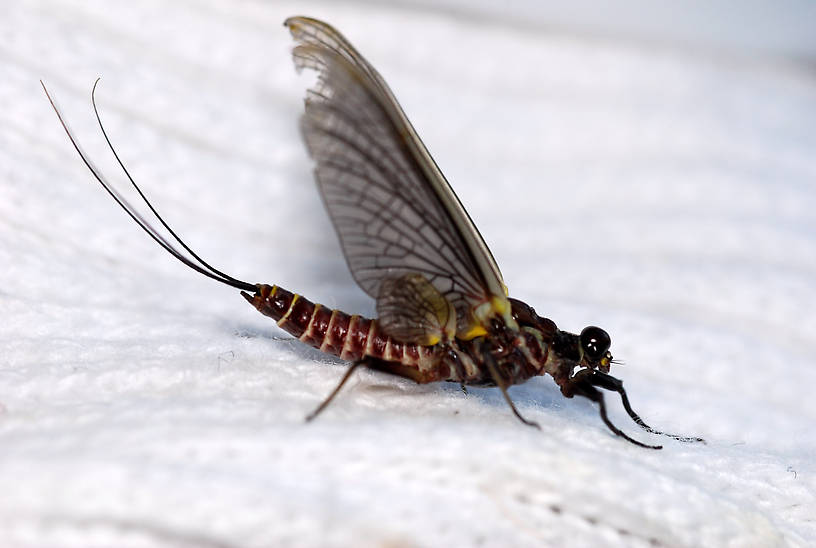
3 Female Duns
8 Nymphs
1 Streamside Picture of Drunella grandis Mayflies:
Start a Discussion of Drunella grandis
References
- Arbona, Fred Jr. 1989. Mayflies, the Angler, and the Trout. Nick Lyons Books.
- Caucci, Al and Nastasi, Bob. 2004. Hatches II. The Lyons Press.
- Knopp, Malcolm and Robert Cormier. 1997. Mayflies: An Angler's Study of Trout Water Ephemeroptera . The Lyons Press.
- Merritt R.W., Cummins, K.W., and Berg, M.B. 2019. An Introduction to the Aquatic Insects of North America (Fifth Edition). Kendall/Hunt Publishing Company.
- Needham, James G., Jay R. Traver, and Yin-Chi Hsu. 1935. The Biology of Mayflies. Comstock Publishing Company, Inc.
- Schwiebert, Ernest G. 1955. Matching the Hatch. MacMillan Publishing Company.
- Swisher, Doug and Carl Richards. 2000. Selective Trout. The Lyons Press.
Mayfly Species Drunella grandis (Western Green Drakes)
Species Range
Common Names
Resources
- NatureServe
- Integrated Taxonomic Information System
- Global Biodiversity Information Facility
- Described by Eaton (1884)

